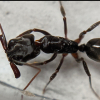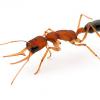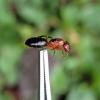- Formiculture.com
- Forums
- Gallery
- Members
- Member Map
- Chat

Creating and managing a more complex ecosystem.
Started By
SuperFrank
, Aug 8 2020 2:06 PM
4 replies to this topic
#1
 Offline
-
Posted August 8 2020 - 2:06 PM
Offline
-
Posted August 8 2020 - 2:06 PM
Using multiple 10 gallon tanks, I hope to create a complex but manageable mini-biome featuring a large variety of species, primarily ants. The ant species have all chosen for their complimentary habits and characteristics.
Right now the project consists of two unconnected vivariums:
The first one is well established in all aspects, housing a two year old Odontomachus brunneus colony that has been in the tank since it's creation. I have recently released a founding colony of Pheidole littoralis into the tank but am unsure if they will be able to survive as they only had a few workers when I released them. I have several founding Crematogaster minutissima colonies which I am debating releasing into the tank when they have a few hundred workers but am wary of them overwhelming the trapjaws.
The second tank is younger, though the substrate is very old and even higher in it's diversity of mites, barklice, springtails and isopods and is generally more "alive". The featured inhabitants of this tank are a young Formica archboldi colony, but there is a Hypoponera colony that inhabited the tank long before them and have been their since it was a pacman frog tank. In addition it houses a Nylanderia faisonensis colony, a (suspected) Solenopsis carolinensis colony and a (suspected) Strumigenys colony. Once the Formica colony is a year or so older I will be connecting the tank to the Odontomachus tank. Formica archboldi is a specialist predator of Odontomachus and I hope to observe this behavior.
In order to be able to manage the ant colonies the tanks will be connected by four 5/8" vinyl tubes, via holes in the sides of the tanks. Two will be a the surface to allow the Formica and Odontomachus to access each other's tanks, while two will be below the surface, to allow the subterranean species to intermingle. If notice a rapid imbalance/decline I should be able to make rapidly disconnect the tubes to allow the weakening colony to recover.
My next planned tank will house a Aphaenogaster ashmeadi colony along with a Pheidole littoralis colony, and the final tank will (ideally) house a Dorymyrmex bureni,. Trachymyrmex septentrionalis, and Solenopsis pergandei colony.
I'll post some pics later tonight and try to keep this up to date, though it's a long term project.
Right now the project consists of two unconnected vivariums:
The first one is well established in all aspects, housing a two year old Odontomachus brunneus colony that has been in the tank since it's creation. I have recently released a founding colony of Pheidole littoralis into the tank but am unsure if they will be able to survive as they only had a few workers when I released them. I have several founding Crematogaster minutissima colonies which I am debating releasing into the tank when they have a few hundred workers but am wary of them overwhelming the trapjaws.
The second tank is younger, though the substrate is very old and even higher in it's diversity of mites, barklice, springtails and isopods and is generally more "alive". The featured inhabitants of this tank are a young Formica archboldi colony, but there is a Hypoponera colony that inhabited the tank long before them and have been their since it was a pacman frog tank. In addition it houses a Nylanderia faisonensis colony, a (suspected) Solenopsis carolinensis colony and a (suspected) Strumigenys colony. Once the Formica colony is a year or so older I will be connecting the tank to the Odontomachus tank. Formica archboldi is a specialist predator of Odontomachus and I hope to observe this behavior.
In order to be able to manage the ant colonies the tanks will be connected by four 5/8" vinyl tubes, via holes in the sides of the tanks. Two will be a the surface to allow the Formica and Odontomachus to access each other's tanks, while two will be below the surface, to allow the subterranean species to intermingle. If notice a rapid imbalance/decline I should be able to make rapidly disconnect the tubes to allow the weakening colony to recover.
My next planned tank will house a Aphaenogaster ashmeadi colony along with a Pheidole littoralis colony, and the final tank will (ideally) house a Dorymyrmex bureni,. Trachymyrmex septentrionalis, and Solenopsis pergandei colony.
I'll post some pics later tonight and try to keep this up to date, though it's a long term project.
- ANTdrew, Antkid12, TechAnt and 2 others like this
#2
 Offline
-
Posted August 8 2020 - 2:20 PM
Offline
-
Posted August 8 2020 - 2:20 PM
Using multiple 10 gallon tanks, I hope to create a complex but manageable mini-biome featuring a large variety of species, primarily ants. The ant species have all chosen for their complimentary habits and characteristics.
Right now the project consists of two unconnected vivariums:
The first one is well established in all aspects, housing a two year old Odontomachus brunneus colony that has been in the tank since it's creation. I have recently released a founding colony of Pheidole littoralis into the tank but am unsure if they will be able to survive as they only had a few workers when I released them. I have several founding Crematogaster minutissima colonies which I am debating releasing into the tank when they have a few hundred workers but am wary of them overwhelming the trapjaws.
The second tank is younger, though the substrate is very old and even higher in it's diversity of mites, barklice, springtails and isopods and is generally more "alive". The featured inhabitants of this tank are a young Formica archboldi colony, but there is a Hypoponera colony that inhabited the tank long before them and have been their since it was a pacman frog tank. In addition it houses a Nylanderia faisonensis colony, a (suspected) Solenopsis carolinensis colony and a (suspected) Strumigenys colony. Once the Formica colony is a year or so older I will be connecting the tank to the Odontomachus tank. Formica archboldi is a specialist predator of Odontomachus and I hope to observe this behavior.
In order to be able to manage the ant colonies the tanks will be connected by four 5/8" vinyl tubes, via holes in the sides of the tanks. Two will be a the surface to allow the Formica and Odontomachus to access each other's tanks, while two will be below the surface, to allow the subterranean species to intermingle. If notice a rapid imbalance/decline I should be able to make rapidly disconnect the tubes to allow the weakening colony to recover.
My next planned tank will house a Aphaenogaster ashmeadi colony along with a Pheidole littoralis colony, and the final tank will (ideally) house a Dorymyrmex bureni,. Trachymyrmex septentrionalis, and Solenopsis pergandei colony.
I'll post some pics later tonight and try to keep this up to date, though it's a long term project.
Wow, brilliant. Brilliant is all I can say, this will be awesome to watch.
My Ants:
(x1) Campontous semitstaceus ~20 workers, 1 Queen
(x1) Camponotus vicinus ~10 workers, 1 Queen (all black variety)
(x1) Tetramorium immigrans ~100 workers, 1 Queen
(x1) Myrmercocystus mexicanus -1 Queen
(x2) Mymercocystus mimcus -1 Queen
(x1) Mymercocystus testaceus ~45 workers, 1 Queen
(x1) Campontous semitstaceus ~20 workers, 1 Queen
(x1) Camponotus vicinus ~10 workers, 1 Queen (all black variety)
(x1) Tetramorium immigrans ~100 workers, 1 Queen
(x1) Myrmercocystus mexicanus -1 Queen
(x2) Mymercocystus mimcus -1 Queen
(x1) Mymercocystus testaceus ~45 workers, 1 Queen
#3
 Offline
-
Posted August 8 2020 - 2:30 PM
Offline
-
Posted August 8 2020 - 2:30 PM
Sounds a lot like Nordic Ants' vivarium!
- TechAnt likes this
#4
 Offline
-
Posted August 8 2020 - 3:11 PM
Offline
-
Posted August 8 2020 - 3:11 PM
I'm excited to see where this goes! Keep us updated. ![]()
#5
 Offline
-
Posted August 8 2020 - 3:29 PM
Offline
-
Posted August 8 2020 - 3:29 PM
Very nice! I might try something like this in the future.
Ants I have: Tapinoma sessile(2 queen colony). RED MORPH Camponotus neacticus(now has pupae!), Tetramorium immigrans (x3), Aphaenogaster sp, Temnothorax sp, Brachymyrmex sp. possibly infertile ![]() , Ponera pennsylvanica, and Pheidole morrisi!
, Ponera pennsylvanica, and Pheidole morrisi! ![]()
Other insects: Polistes sp. Queen
Ants I need: Pheidole sp., Trachymyrmex sp., Crematogaster cerasi , Dorymyrmex sp. Most wanted: Pheidole morrisii
1 user(s) are reading this topic
0 members, 1 guests, 0 anonymous users


















